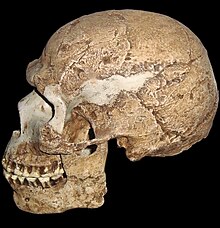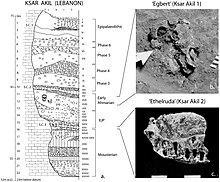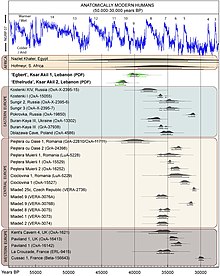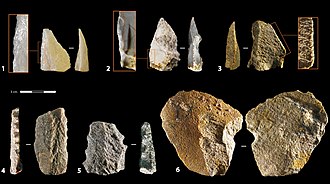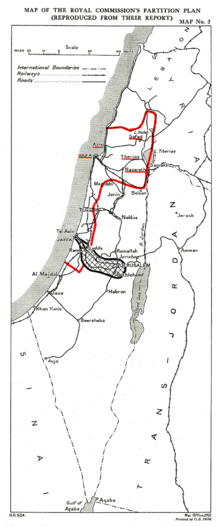| The ancient Near East |
|---|
 |
| Regions and states |
|
The Levant |
| Archaeological periods |
| Languages |
| Literature |
| Mythology |
| Other topics |
The genetic history of the Middle East is the subject of research within the fields of human population genomics, archaeogenetics and Middle Eastern studies. Researchers use Y-DNA, mtDNA, and other autosomal DNAs to identify the genetic history of ancient and modern populations of Egypt, Persia, Mesopotamia, Anatolia, Arabia, the Levant, and other areas.
History
Developments in DNA sequencing in the 1970s and 1980s provided researchers with the tools needed to study human genetic variation and the genetics of human populations to discover founder populations of modern people groups and human migrations.
In 2005, National Geographic launched The Genographic Project, led by 12 prominent scientists and researchers, to study and map historical human migration patterns by collecting and analyzing DNA samples from hundreds of thousands of people from around the world.
Regions
Egypt
Contamination from handling and intrusion from microbes create obstacles to the recovery of Ancient DNA. Consequently, most DNA studies have been carried out on modern Egyptian populations with the intent of learning about the influences of historical migrations on the population of Egypt.
In general, various DNA studies have found that the genetic variant frequencies of North African populations are intermediate between those of the Near East, the Horn of Africa, southern Europe and Sub Saharan Africa, though Egypt's NRY frequency distributions appear to be much more similar to those of the Middle East than to any sub-Saharan African population, suggesting a much larger Eurasian genetic component in samples examined .
A recent genetic study published in the "European Journal of Human Genetics" (2019) showed that Northern Africans (including Egyptians) are closely related to Europeans and West Asians as well as to Southwest Asians. Northern Africans can clearly be distinguished from West Africans and other African populations dwelling south of the Sahara.
Blood groups
Blood typing and DNA sampling on ancient Egyptian mummies is scant; however, a 1982 study of blood typing of dynastic mummies found ABO frequencies to be most similar to modern Egyptians and some also to Northern Haratin populations. ABO blood group distribution shows that the Egyptians form a sister group to North African populations, including Berbers, Nubians and Canary Islanders.
Ancient Egyptians
In 2013, Nature announced the publication of the first genetic study utilizing next-generation sequencing to ascertain the ancestral lineage of an Ancient Egyptian individual. The research was led by Carsten Pusch of the University of Tübingen in Germany and Rabab Khairat, who released their findings in the Journal of Applied Genetics. DNA was extracted from the heads of five Egyptian mummies that were housed at the institution. All the specimens were dated between 806 BC and 124 AD, a timeframe corresponding with the late Dynastic period. The researchers observed that one of the mummified individuals likely belonged to the mtDNA haplogroup I2, a maternal clade that is believed to have originated in Western Asia.
In a 2017 study published in Nature, three Egyptian mummies were obtained spanning around 1,300 years of Egyptian history from the New Kingdom to the Roman period. Analyses revealed that ancient Egyptians shared more ancestry with Near Easterners than present-day Egyptians, who received additional sub-Saharan admixture in more recent times, around 750 years ago.
Iran
Iranian peoples descended from two closely related West-Eurasian groups, specifically from "Neolithic Iranian farmers" and from "Yamnaya Steppe pastoralists". Recent population genomic studies found that the genetic structure of Iranian peoples formed already about 5,000 years ago and show high continuity since then, suggesting that they were largely unaffected by migration events from outside groups. Genetically speaking, Iranian peoples generally cluster closely with European peoples and populations south to the Caucasus, however certain ethno-linguistic minority groups, such as Turkmens, are more distant and show evidence of recent admixture. Persians, Kurds, Azeris, Tajiks, Pashtuns, Balochis, and certain Uzbek samples, cluster tightly together, forming a single cluster, known as CIC (Central Iranian cluster). Compared with worldwide populations, Iranians (CIC) cluster in the center of the wider West-Eurasian cluster, close to Europeans, Middle Easterners, and South-Central Asians. Interestingly, Iranian Arabs and Azeris are nearly indistinguishable from other Iranian groups, suggesting that linguistic identity is less relevant within Iran. Parsi samples from India were surprisingly found to be part of the Iranian cluster (CIC). The genetic substructure of Iranians is surprisingly low and homogeneous, compared with other "1000G" populations. Europeans, and certain South Asians (Indians) showed the highest affinity with Iranians, while Sub-Saharan Africans and East Asians showed the highest differentiation with Iranians.
Genetic links to neolithic Anatolia
A 2017 study analyzed the autosomal DNA and genome of an Iron Age Iranian sample taken from Teppe Hasanlu (F38_Hasanlu, dated to 971-832 BCE) and revealed it had close affinities to a neolithic North-West Anatolian individual from Kumtepe even closer than Neolithic Iranians.
Gilaks and Mazandaranis
A 2006 genetic research was made by Nasidze et al. on the North Iranian populations on the Gilaks and Mazandaranis, spanning the southwestern coast of the Caspian Sea, up to the border with neighbouring Azerbaijan. The Gilaks and Mazandaranis comprise 7% of the Iranian population. The study suggested that their ancestors came from the Caucasus region, perhaps displacing an earlier group in the South Caspian. Linguistic evidence supports this scenario, in that the Gilaki and Mazandarani languages (but not other Iranian languages) share certain typological features with Caucasian languages, and specifically South Caucasian languages. There have been patterns analyzed of mtDNA and Y chromosome variation in the Gilaki and Mazandarani.
Based on mtDNA HV1 sequences tested by Nasidze et al., the Gilaks and Mazandarani most closely resemble their geographic and linguistic neighbors, namely other Iranian groups. However, their Y chromosome types most closely resemble those found in groups from the South Caucasus. A scenario that explains these differences is a south Caucasian origin for the ancestors of the Gilani and Mazandarani, followed by introgression of women (but not men) from local Iranian groups, possibly because of patrilocality. Given that both mtDNA and language are maternally transmitted, the incorporation of local Iranian women would have resulted in the concomitant replacement of the ancestral Caucasian language and mtDNA types of the Gilani and Mazandarani with their current Iranian language and mtDNA types. Concomitant replacement of language and mtDNA may be a more general phenomenon than previously recognized.
The Mazandarani and Gilani groups fall inside a major cluster consisting of populations from the Caucasus and West Asia and are particularly close to the South Caucasus groups—Georgians, Armenians, and Azerbaijanis. Iranians from Tehran and Isfahan are situated more distantly from these groups.
Iranian Azeris
The 2013 comparative study on the complete mitochondrial DNA diversity in Iranians has indicated that Iranian Azerbaijanis are more related to the people of Georgia, than they are to other Iranians (Like Persians), while the Persians, Armenians and Qashqai on the other hand were more related to each other. It furthermore showed that overall, the complete mtDNA sequence analysis revealed an extremely high level of genetic diversity in the Iranian populations studied which is comparable to the other groups from the South Caucasus, Anatolia and Europe. The same 2013 research further noted that "the results of AMOVA and MDS analyses did not associate any regional and/or linguistic group of populations in the Anatolia, Caucasus and Iran region pointing to strong genetic affinity of Indo-European speaking Persians and Turkic-speaking Qashqais, thus suggesting their origin from a common maternal ancestral gene pool. The pronounced influence of the South Caucasus populations on the maternal diversity of Iranian Azeris is also evident from the MDS analysis results." The study also notes that "It is worth pointing out the position of Azeris from the Caucasus region, who despite their supposed common origin with Iranian Azeris, cluster quite separately and occupy an intermediate position between the Azeris/Georgians and Turks/Iranians grouping". The MtDNA results from the samples overall on average closely resemble those found in the neighbouring regions of the Caucasus, Anatolia, and to a lesser extent (Northern) Mesopotamia.
Among the most common MtDNA lineages in the nation, namely U3b3, appears to be restricted to populations of Iran and the Caucasus, while the sub-cluster U3b1a is common in the whole Near East region.
Iraq
Ancient genetic links to South Asia
A 2013 study based on DNA extracted from the dental remains of four individuals from different time eras (200–300 CE, 2650-2450 BCE, 2200–1900 BCE) unearthed at Tell Ashara (ancient Terqa, in modern Syria) and Tell Masaikh (ancient Kar-Assurnasirpal) suggested a possible genetic link between the people of Bronze Age Mesopotamia and Northern India. According to the study, "We anticipate that the analysed remains from [northern] Mesopotamia belonged to people with genetic affinity to the Indian subcontinent since the distribution of identified ancient haplotypes indicates solid link with populations from the region of South Asia-Tibet (Trans-Himalaya). They may have been descendants of migrants from much earlier times, spreading the clades of the macrohaplogroup M throughout Eurasia and founding regional Mesopotamian groups like that of Terqa or just merchants moving along trade routes passing near or through the region." A 2014 study expanding on the 2013 study and based on analysis of 15751 DNA samples arrives at the conclusion, that "M65a, M49 and/or M61 haplogroups carrying ancient Mesopotamians might have been the merchants from India".
Assyrians
In the 1995 book The History and Geography of Human Genes the authors wrote that: "The Assyrians are a fairly homogeneous group of people, believed to originate from the land of old Assyria in northern Iraq [..] they are Christians and are bona fide descendants of their ancient namesakes." In a 2006 study of the Y chromosome DNA of six regional populations, including, for comparison, Assyrians and Syrians, researchers found that, "the two Semitic populations (Assyrians and Syrians) are very distinct from each other according to both [comparative] axes. This difference supported also by other methods of comparison points out the weak genetic affinity between the two populations with different historical destinies."
A 2008 study on the genetics of "old ethnic groups in Mesopotamia," including 340 subjects from seven ethnic communities ("These populations included Assyrians, Jews, Zoroastrians, Armenians, Arabs and Turkmen (representing ethnic groups from Iran, restricted by rules of their religion), and the Iraqi and Kuwaiti populations from Iraq and Kuwait.") found that Assyrians were homogeneous with respect to all other ethnic groups sampled in the study, regardless of religious affiliation.
Marsh Arabs
A study published in 2011 looking at the relationship between Iraq's Marsh Arabs and ancient Sumerians concluded "the modern Marsh Arabs of Iraq harbour mtDNAs and Y chromosomes that are predominantly of Middle Eastern origin. Therefore, certain cultural features of the area such as water buffalo breeding and rice farming, which were most likely introduced from the Indian sub-continent, only marginally affected the gene pool of the autochthonous people of the region. Moreover, a Middle Eastern ancestral origin of the modern population of the marshes of southern Iraq implies that, if the Marsh Arabs are descendants of the ancient Sumerians, also Sumerians were not of Indian or Southern Asian ancestry." The same 2011 study, when focusing on the genetics of the Maʻdān people of Iraq, identified Y chromosome haplotypes shared by Marsh Arabs, Arabic speaking Iraqis, Assyrians and Mandeans "supporting a common local background."
Levant
Chalcolithic and Bronze Age periods
From a 2020 study published in Cell: "Understanding the nature of this movement was the primary motivation behind this study. Here, we present a large-scale analysis of genome-wide data from key sites of prehistoric Anatolia, the Northern Levant, and the Southern Caucasian lowlands ... In the Northern Levant, we identified a major genetic shift between the Chalcolithic and Bronze Age periods. During this transition, Northern Levantine populations experienced gene flow from new groups harboring ancestries related to both Zagros/Caucasus and the Southern Levant. This suggests a shift in social orientation, perhaps in response to the rise of urban centers in Mesopotamia, which to date remain genetically unsampled." They further add: "This expansion is recorded in the region of the Northern Levant ca. 2800 BCE and could be associated with the movement/ migration of people from Eastern Anatolia and the Southern Caucasian highlands. However, our results do not support this scenario for a number of reasons". "There are extensive textual references from the end of the EBA through the LBA referring to groups of people arriving into the area of the Amuq Valley. Although these groups were named, likely based on designations (e.g., Amorites, Hurrians), the formative context of their (cultural) identity and their geographic origins remain debated. One recent hypothesis (Weiss, 2014, 2017; Akar and Kara, 2020) associates the arrival of these groups with climate-forced population movement during the ‘‘4.2k BP event,’’ a Mega Drought that led to the abandonment of the entire Khabur river valley in Northern Mesopotamia and the search of nearby habitable areas."
The study also suggested a substantial genetic continuity from the Levantine Bronze Age both in modern-day Arabic-speaking Levantine populations (such as Syrians, Druze, Lebanese, and Palestinians) and Jewish groups (such as Moroccan, Ashkenazi, and Mizrahi Jews), who are all suggested to derive a majority (about half or more) of their ancestry from Canaanite-related or Bronze Age Levantine populations (with differering variables for different communities, and with Ashkenazi Jews deriving just over half of their ancestry from Bronze-Age Levantines/Canaanite-related peoples and the rest from Europeans, and Arabic-speaking Levantines, Moroccan Jews, and Mizrahi Jews deriving a larger majority of their ancestry from Bronze Age Canaanite-related peoples). The study concludes that this does not mean that any of these present-day groups bear direct ancestry from people who lived in the Middle-to-Late Bronze Age Levant or in Chalco-lithic Zagros; rather, it indicates that they have ancestries from populations whose ancient proxy can be related to the Middle East.
Canaanites and Phoenicians
Zalloua and Wells (2004), under the auspices of a grant from National Geographic Magazine, examined the origins of the Canaanite Phoenicians. The debate between Wells and Zalloua was whether haplogroup J2 (M172) should be identified as that of the Phoenicians or that of its "parent" haplogroup M89 on the YDNA phylogenetic tree. Initial consensus suggested that J2 be identified with the Canaanite-Phoenician (North Levantine) population, with avenues open for future research. As Wells commented, "The Phoenicians were the Canaanites" It was reported in the PBS description of the National Geographic TV Special on this study entitled "Quest for the Phoenicians" that ancient DNA was included in this study as extracted from the tooth of a 2500-year-old Phoenician mummy.
Wells identified the haplogroup of the Canaanites as haplogroup J2 which originated from Anatolia and the Caucasus. The National Geographic Genographic Project linked haplogroup J2 to the site of Jericho, Tel el-Sultan, ca. 8500 BCE and indicated that in modern populations, haplogroup J2 is found primarily in the Middle East, but also along the coasts of North Africa and Southern Europe, with especially high distribution among present-day Jewish populations (30%), Southern Italians (20%), and lower frequencies in Southern Spain (10%).
Cyprus
Cruciani in 2007 found E1b1b1a2 (E-V13) [one from Sub Clades of E1b1b1a1 (E-M78)] in high levels (>10% of the male population) in Cypriot and Druze lineages. Recent genetic clustering analyses of ethnic groups are consistent with the close ancestral relationship between the Druze and Cypriots, and also identified similarity to the general Syrian and Lebanese populations, as well as a variety of Jewish lineages (Ashkenazi, Sephardi, Iraqi Jewish, and Moroccan Jews).
A 2016 study on 600 Cypriot males asserts that "genome-wide studies indicate that the genetic affinity of Cyprus is nearest to current populations of the Levant". Analyses of Cypriot haplogroup data are consistent with two stages of prehistoric settlement. E-V13 and E-M34 are widespread, and PCA suggests sourcing them to the Balkans and Levant/Anatolia, respectively. Contrasting haplogroups in the PCA were used as surrogates of parental populations. Admixture analyses suggested that the majority of G2a-P15 and R1b-M269 components were contributed by Anatolia and Levant sources, respectively, while Greece/Balkans supplied the majority of E-V13 and J2a-M67. Haplotype-based expansion times were at historical levels suggestive of recent demography. On the other hand, more recent Principal Component Analyses based on autosomal DNA, have placed Cypriots clearly separate from Levantine and Middle Eastern groups, either at the easternmost flank of the south European cluster, or in an intermediate position between southern Europeans and northern Levantines. In a study by Harvard geneticist Iosif Lazarides and colleagues investigating the genetic origins of the Minoans and Mycenaeans, Cypriots were found to be the second least differentiated population from Bronze Age Mycenaeans based on FST index and also genetically differentiated from Levantines.
Palestine and Israel
A study published by the National Academy of Sciences found that "the paternal gene pools of Jewish communities from Europe, North Africa, and the Middle East descended from a common Middle Eastern ancestral population", and suggested that "most Jewish communities have remained relatively isolated from neighbouring non-Jewish communities during and after the Diaspora". Researchers expressed surprise at the remarkable genetic uniformity they found among modern Jews, no matter where the diaspora has become dispersed around the world. Skorecki and colleague wrote that "the extremely close affinity of Jewish and non-Jewish Middle Eastern populations observed ... supports the hypothesis of a common Middle Eastern origin".
This research has suggested that, in addition to Israelite male, significant female founder ancestry might also derive from the Middle East-with 40% of Ashkenazim descended from four women who lived about 2000–3000 years ago in the Middle East. In addition, Behar (2006) suggested that the rest of Ashkenazi mtDNA is originated from about 150 women; most of those were probably of Middle Eastern origin. A 2013 genetic study suggested that the four founding maternal lineages of Ashkenazi Jews originate in Europe and that only ~8% of Ashkenazi mtDNA can confidently be assigned a Near Eastern origin, while >80% of Ashkenazi maternal lineages have a likely European origin (with most Ashkenazi paternal lineages having a Middle Eastern origin), while a 2014 study carried out by Spanish geneticists suggested an ancient Near Eastern origin of the four founding maternal lineages of Ashkenazi Jews.
In 2004, a team of geneticists from Stanford University, the Hebrew University of Jerusalem, Tartu University (Estonia), Barzilai Medical Center (Ashkelon, Israel), and the Assaf Harofeh Medical Center (Zerifin, Israel), studied the modern Samaritan ethnic community living in Israel in comparison with modern Israeli populations to explore the ancient genetic history of these people groups. The Samaritans or Shomronim (singular: Shomroni; Hebrew: שומרוני) trace their origins to the Assyrian province of Shomron (Samaria) in ancient Israel in the period after the Assyrian conquest circa 722 BCE. Shomron was the capital of the Northern Kingdom of Israel when it was conquered by the Assyrians and gave the name to the ancient province of Samaria and the Samaritan people group. Jewish tradition holds that the Samaritans were a mixed group of Israelites who were not exiled or were sent back or returned from exile and non-Israelites relocated to the region by the Assyrians. The modern-day Samaritans are believed to be the direct descendants of the ancient Samaritans.
Their findings reported on four family lineages among the Samaritans: the Tsdaka family (tradition: tribe of Menasseh), the Joshua-Marhiv and Danfi families (tradition: tribe of Ephraim), and the Cohen family (tradition: tribe of Levi). All Samaritan families were found in haplogroups J1 and J2, except the Cohen family which was found in haplogroup E3b1a-M78. This article predated the E3b1a subclades based on the research of Cruciani, et al.
A 2018 study conducted by scholars from Tel-Aviv University, the Israel Antiquities Authority and Harvard University had discovered that 22 out of the 600 people who were buried in Peki'in cave from the Chalcolithic Period were of both local Levantine and Persian and Zagros area ancestries, or as phrased in the paper itself: "Ancient DNA from Chalcolithic Israel reveals the role of population mixture in cultural transformation," the scientists concluded that the homogeneous community found in the cave could source ~57% of its ancestry from groups related to those of the local Levant Neolithic, ~26% from groups related to those of the Anatolian Neolithic, and ~17% from groups related to those of the Iran Chalcolithic. The scholars noted that the Zagros genetic material held "Certain characteristics, such as genetic mutations contributing to blue eye color, were not seen in the DNA test results of earlier Levantine human remains"...The blue-eyed, fair-skinned community didn’t continue, but at least now researchers have an idea why. "These findings suggest that the rise and fall of the Chalcolithic culture are probably due to demographic changes in the region".
In a 2005 study of ASPM gene variants, Mekel-Bobrov et al. found that the Israeli Druze people of the Carmel region have among the highest rate of the newly evolved ASPM haplogroup D, at 52.2% occurrence of the approximately 6,000-year-old allele. While it is not yet known exactly what selective advantage is provided by this gene variant, the haplogroup D allele is thought to be positively selected in populations and to confer some substantial advantage that has caused its frequency to rapidly increase. According to DNA testing, Druze are remarkable for the high frequency (35%) of males who carry the Y-chromosomal haplogroup L, which is otherwise uncommon in the Mideast. This haplogroup originates from prehistoric South Asia and has spread from Pakistan into southern Iran.
Lebanon
In a 2011 genetic study by Haber et al which analyzed the male-line Y-chromosome genetics of the different religious groups of Lebanon, revealed no noticeable or significant genetic differentiation between the Maronites, Greek Orthodox Christians, Greek Catholic Christians, Sunni Muslims, Shiite Muslims, and Druze of the region on the more frequent haplogroups. Major differences between Lebanese groups were found among the less frequent haplogroups. In 1965, Ruffié and Taleb found significant differences of blood markers between ethno-religious groups. A 2005 study by Makhoul et al on Beta Thalassemia Heterogeneity in Lebanon found out that the thalassemia mutations in some Lebanese Christians are similar to the ones observed in Macedonia which "may confirm the presumed Macedonian origin of certain Lebanese Christians".
A 2013 genetic study carried out by Haber at al found "all Jews (Sephardi and Ashkenazi) cluster in one branch; Druze from Mount Lebanon and Druze from Mount Carmel are depicted on a private branch; and Lebanese Christians form a private branch with the Christian populations of Armenia and Cyprus placing the Lebanese Muslims as an outer group. Lebanese Muslims cluster towards the predominant Muslim populations of Syrians, Palestinians, and Jordanians, which in turn cluster on branches with other Muslim populations as distant as Morocco and Yemen."
The authors explained that "In particular, conversion of the region's populations to Islam appears to have introduced major rearrangements in populations' relations through admixture with culturally similar but geographically remote populations, leading to genetic similarities between remarkably distant populations like Jordanians, Moroccans, and Yemenis. Conversely, Christians, Jews and Druze became genetically isolated in the new cultural environment." In conclusions, the authors reconstructed the genetic structure of ancient Levantines and found that a pre-Islamic expansion Levant was more genetically similar to Europeans than to Arabians.
A 2017 study published by the American Journal of Human Genetics, concluded that present-day Lebanese derive most of their ancestry from a Canaanite-related population (Canaanite being a pre-Phoenician name), which therefore implies substantial genetic continuity in the Levant since at least the Bronze Age. More specifically, according to Chris Tyler-Smith, a geneticist and his colleagues at the Sanger Institute in Britain, who compared "sampled ancient DNA from five Canaanite people who lived 3,750 and 3,650 years ago" to modern people. "The comparison revealed that 93 percent of the genetic ancestry of people in Lebanon came from the Canaanites and the other 7 percent was of a Eurasian steppe population"
A 2019 study, carried out by the Wellcome Sanger Institute, United Kingdom, after analyzing the "DNA evidence from the remains of nine Crusaders found at a burial site in Lebanon", concludes that contrary to the popular belief, the Crusaders did not leave "a lasting effect on the genetics of modern-day Lebanese. Instead, today’s Lebanese Christians in particular are more genetically similar to locals from the Roman period, which preceded the Crusades by more than four centuries."
Turkey
Turkish genomic variation, along with several other Western Asian populations, looks most similar to genomic variation of South European populations such as southern Italians. Data from ancient DNA – covering the Paleolithic, the Neolithic, and the Bronze Age periods – showed that Western Asian genomes, including Turkish ones, have been greatly influenced by early agricultural populations in the area; later population movements, such as those of Turkic speakers, also contributed. The first and only (as of 2017) whole genome sequencing study in Turkey was done in 2014. Moreover, the genetic variation of various populations in Central Asia "has been poorly characterized"; Western Asian populations may also be "closely related to populations in the east". An earlier 2011 review had suggested that "small-scale, irregular punctuated migration events" caused changes in language and culture "among Anatolia's diverse autochthonous inhabitants," which explains Anatolian populations' profile today.
